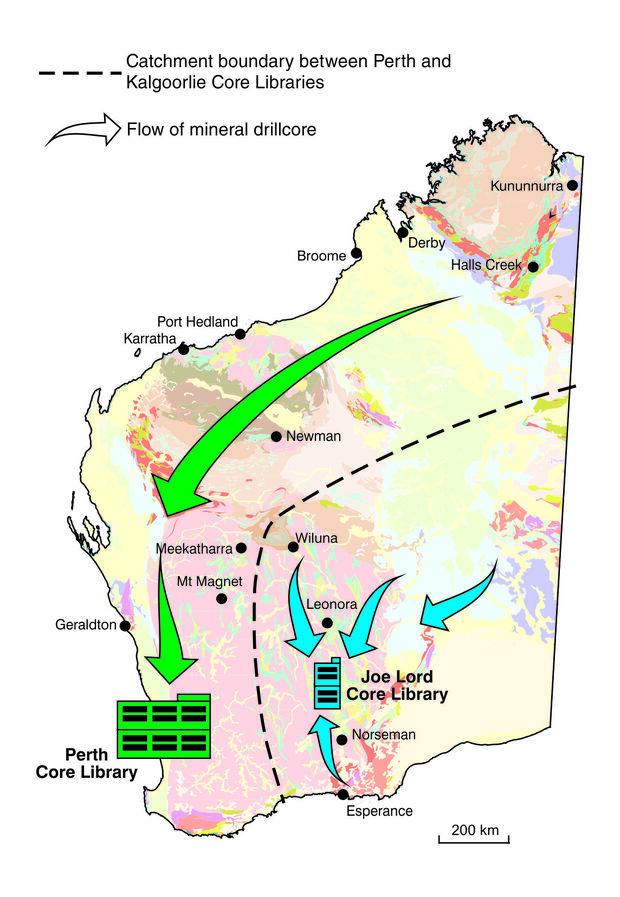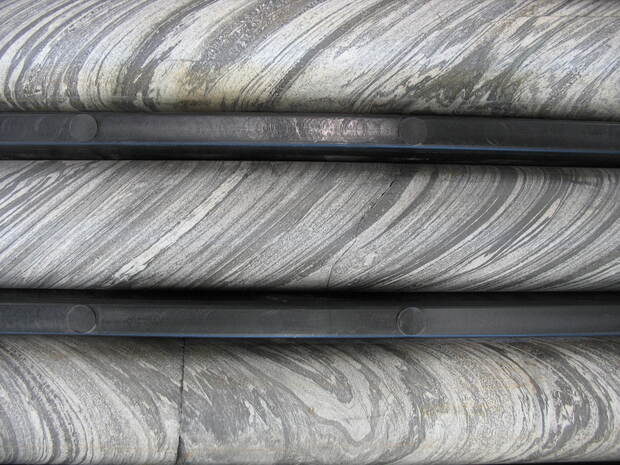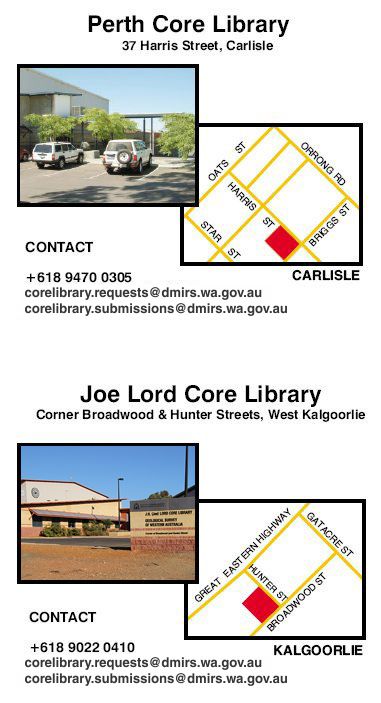Core library services and drillcore
The department recognises the importance of storing drillcore acquired during mineral and petroleum exploration in Western Australia. Drillcore is an important tool for industry stakeholders to develop geological models and exploration programs.
Western Australia has two purpose-built core libraries, the Perth Core Library, located in Carlisle, and the Joe Lord Core Library in Kalgoorlie. The core libraries are used to display and archive drillcore to assist subsequent exploration activity. Both facilities are administered by the Geological Survey of Western Australia (GSWA).
The Perth Core Library houses the HyLogger spectral scanner, a rapid spectroscopic logging and imaging system that uses continuous visible and infrared spectroscopy and digital imaging to safely examine core, samples and cuttings.


Petroleum core
Companies are required to submit cores, cuttings and sidewall core material obtained during drilling as part of the legislative requirements for petroleum and geothermal exploration. These samples become available to the public after a strict confidentiality period.
Mineral core

Drillcore perceived as valuable to the minerals industry is archived by the department. The selection criteria take into consideration the department's need to promote the mineral prospectivity of Western Australia. Record 2002/14 Selection criteria for mineral drillcore in the Western Australian core libraries describes the method used for the selection of mineral drillcore for the core libraries.
Core may be selected from:
- significant mines that have closed or are soon to close
- significant mineralisation that illustrates a range of mineral commodities, styles of mineralisation, or tectonic settings
- deposits that illustrate a geographic distribution throughout the State
- areas that may be difficult or expensive to redrill, such as urban areas, national parks, remote areas or deep holes
- deposits that are excellent examples of stratigraphy, significant structural features or unusual geological features
- prospects or areas popular with the minerals industry including core from subeconomic prospects that may allow prospectors and mining companies to test innovative processes or ideas, or core from prospects that are under joint-venture proposals and have a large demand for viewing.
Submitting drillcore

All petroleum core should be sent to the Perth Core Library. Processing petroleum drillcore into trays: Perth Core Library guidelines outlines the standard process for those handling and viewing drillcore. It covers the best practices for processing drillcore into trays, common mistakes when processing drillcore into trays, and ordering core trays.
Mineral core from the Eastern Goldfields and the southeastern portion of Western Australia should be submitted to the Joe Lord Core Library in Kalgoorlie.
Mineral core from the Kimberley, Pilbara, Gascoyne, Murchison districts and the southwest of Western Australia should be submitted to the Perth Core Library.
A small percentage of mineral core is stored in the core libraries. Companies must retain their own core archive, making it available to the department core library if requested. They must also provide three months’ written notice if they plan to destroy the core.
Guidelines for the submission and delivery of mineral drillcore provides more information on this process and access to the relevant forms.
Arrangements must be made with the Core Librarian prior to submission.
Core library submission form
Viewing and sampling drillcore

Mineral drill core stored in the Perth and Kalgoorlie core libraries is owned and managed by the Department of Mines, Industry Regulation and Safety.
Industry stakeholders and members of the public are welcome to inspect drillcore archived at the department's core libraries in Perth and Kalgoorlie.
You can view what mineral drillholes are available at the core libraries via our department's website and using the online system GeoVIEW.WA
Once in GeoVIEW.WA, tick the 'Drillholes' folder then expand the folder by expanding on the plus sign and tick the 'Core Library Drillholes' layer. The blue circles on the map are mineral drillholes that are stored at the Kalgoorlie Core Library, the red circles on the map are the mineral drillholes stored at the Perth Core Library.
A request to view drillcore can be made to DMIRS and once approval has been given the core is available to view at the agreed time.
To make a booking to visit one of the core libraries and view the core email corelibrary.requests@dmirs.wa.gov.au
Sampling of drillcore is permitted on a case-by-case basis. The rules listed below will apply.
Sampling Rules:
- EIS-funded core is only available to sample after it is has been hylogged by DMIRS.
- Sampling quarter core intervals is preferred.
- At least quarter core remains available after sampling.
- Sampling for metallurgical testwork will not be permitted.
- Unless specific permission is otherwise granted, a maximum quarter core length of 15cm for fine-grained (e.g. basalt) rocks, and 25cm for medium- to coarse-grained (e.g. typical granite/gabbro) or texturally inhomogeneous (e.g. porphyritic) rocks can be taken.
- Sample lengths for thin sections should be no more than 5cm. All thin sections should be polished thin sections (25 x 48 mm polished thin sections with no cover slips).
- Sampling will not be approved if the same intervals have been sampled previously for the same style of investigations.
- Certain reference core or “type” section core can be viewed but not sampled (see regularly updated Restricted core list).
- Where sampling is approved, extraction of samples will be performed by departmental personnel at an agreed time.
- Any variation to these rules must be approved in writing by the Director Geoscience or Director Mineral and Petroleum Resources, GRSD.
- Data from sampling must be provided to GRSD in an acceptable format within 6 months of the sampling taking place.
- All unused material and derivative material (slides, mounts, etc.) must be returned to the Department within 6 months of the sampling taking place.
- An individual, and the project (and associated team members) and the institution to which they belong will be refused sampling on any current or future projects if results of previous sampling have not been received in an acceptable format within the prescribed 6 month period. What GSWA considers acceptable in terms of geochronological and geochemical data (including analytical procedures, prescribed range of elements and reporting of metadata) is clearly set out in the sampling agreement form that you have signed.
- Please acknowledge GSWA as the source of materials in any publishing data arising from the use of GSWA samples.
Other drillcore analyses
The Perth Core Library offers complimentary services to analyse core and chip samples from the department’s collection using portable X-Ray Fluorescence (pXRF) and X-Ray Diffractometry (pXRD) instruments.
The XRF service uses a hand-held Olympus Vanta M Series analyser to measure elemental compositions of geological samples, from Mg to U, and from parts per million to 100%. This service is currently available at the Perth Core Library and the Joe Lord (Kalgoorlie) Core Library.
The XRD service employs an Olympus BTX-II benchtop diffractometer to identify minerals in <1 g powdered geological samples, and is only available at the Perth Core Library.
Requirements:
- Email requests for pXRF or pXRD analyses to corelibrary.requests@dmirs.wa.gov.au
- Requests are limited to 50 analyses for pXRF, and one analysis for pXRD
- For approved requests, the applicant will be issued with an approval number and a sample ID/agreement form
- Analyses will be performed by departmental personnel
- XRF data will be delivered in an Excel spreadsheet and XRD results will be delivered as raw data files and a table with interpreted mineralogy
- All information will generally be released to open file as soon as practicable (a short period of confidentiality may be negotiated).
Donating mineral drillcore
The department welcomes donations of significant core drilled before 2006.
Any tenement holder or company wishing to donate core should contact:
Core Library Coordinator
Phone: (08) 9222 3840
Email: corelibrary.submissions@dmirs.wa.gov.au

Contact
For more information, contact:
Perth
Perth Core Library
37 Harris Street, Carlisle WA 6101
Phone: 08 9470 0305
Email: corelibrary.requests@dmirs.wa.gov.au or corelibrary.submissions@dmirs.wa.gov.au
See address on Google Maps
Kalgoorlie
Joe Lord Core Library
Corner Broadwood & Hunter Streets, West Kalgoorlie WA 6430
Phone: 08 9022 0410
Email: corelibrary.requests@dmirs.wa.gov.au or corelibrary.submissions@dmirs.wa.gov.au
See address on Google Maps
